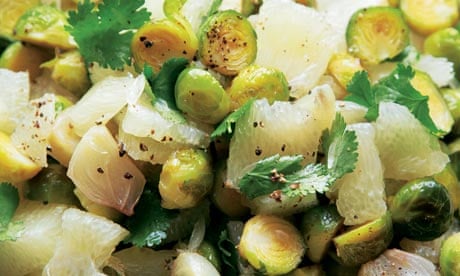Pomelo
- rosemary
- Jul 24, 2022
- 4 min read
"The gentle giants of the citrus world, pomelos have a fragrant sweetness balanced by a mild tartness—think grapefruit with less bitterness."
Fine Cooking

This morning we took our granddaughter to her footy game. We had to arrive around an hour prior to the game, so her older sister and I wandered over the road to a newish food store, which I had visited once before, and which I knew had some interesting things in it, so I thought it would entertain my granddaughter - now a young teenager, and therefore easily bored - well superficially anyway.
One of the first things we came across were these pomelos. They were huge - as you can see from the other photos I took below.
The two photos on the outer edges here are of ruby pomelo, though the outside didn't look very ruby, and they were even larger than the ones that had caught our eye. Those green things next to them are large melons. And you can just see some apples on the left to compare as well.
I mistakenly told her that they were a cross from grapefruit and something else. Which I now see is completely wrong, as it's sort of the other way round. Pomelos in fact
"are one of six core, ancient citrus species that the rest of the citrus available today is cultivated from." Palisa Anderson
In fact the orange - not one of those core ancient citrus was a cross between the pomelo and the mandarin. The orange then crossed with the pomelo to give us grapefruit, whose taste it resembles, only sweeter and not quite as juicy. Apparently it also resembles the grapefruit in that it interferes with the efficacy of some drugs - statins being one of them. I take statins, and so am unable to eat grapefruit, which is a bit of a tragedy for me. And now it seems I can't eat pomelos either.

"the heavy fruit you have in front of you grew at the end of a very slim branch, the diameter of a pianist’s pinkie. It has taken months to get to this weight and size, without snapping the slender stalk – talk about resilience." Palisa Anderson
And I gather it's also a bit of a battle to get at the fruit. As you can see from my first photograph, the skin is very thick - which doesn't mean that the peel cannot be used like any other citrus peel. Just as flavourful and great in marinades, marmalades, drinks, sauces ... But be sure to discard the skin surrounding the actual fruit segments because that is bitter.
"Digging through its floral-perfumed skin and thick, spongy pith to uncover the fresh, jewel-like fruit is a little like uncovering a buried treasure." Fine Cooking
It's a native of Java and Malaysia - well all citrus are Asian I think, and it seems to be the Asians who use it most - mostly in salads with shellfish.

It's also considered a lucky dish for the Chinese New Year - indeed I found one Chinese inspired recipe called Chinese New Year chicken and pomelo salad with a sweet plum dressing, which looked rather tempting, although the auther Sally Courtney seems not to be Asian.
We Europeans first became aware of it in the seventeenth century when the Dutch in the East Indies called it pompelmoes - 'pomp' meaning pumpkin and 'elmoes' meaning a citron - one of those other ancient citrus fruits. So sort of 'pumpkin sized citron'. This was Frenchified to Pamplemousse - and yes I know - that means grapefruit in French. But not back then. In England it was also called a Shaddock after a captain who had taken it to Barbados where it became a cultivated crop - indeed in many of the British West Indies islands. Today Israel is the big supplier for Europe, whilst the Americans (and us) grow their own. Anyway today it is pomelo and 'pamplemousse' is indeed grapefruit in french.
I don't think they sell it in the major supermarkets as yet, but you never know. So what can you do with it?
"In addition to chile, pomelo pairs well with herbs like cilantro, mint, and basil; tropical fruits such as pineapple, coconut, and mango; spring vegetables, including carrots, radishes, and onions; and shellfish like scallops and shrimp." Fine Cooking
Fundamentally use it like grapefruit, but you won't need to add as much honey or sugar to allay the bitterness of grapefruit. There are lots and lots of recipes for salads, and here are a few, together with a couple of outliers - below the salads: Seared prawns and pomelo salad from Ottolenghi - prawns are a very popular accompaniment - Pomelo salad with prawns from Diana Chan. Or just try a Pomelo salad from Australian Women's Weekly. The SBS website had a rather lovely video - and recipe - of Tetsuya Wakada making Grilled Spanish mackerel - really it was just about the mackerel but it was also accompanied by a pomelo salad.
As to actually cooking with pomelo - Ottolenghi has a go with Roasted Brussels sprouts and pomelo and, to my mind, the most tempting dish was Pomelo Chicken Francese from Julissa Roberts on the Fine Cooking website.
But I won't be making it - those damned statins. A bit of a cheat post I know, but I was so stunned by the size of this fruit. Oh and if you do see some and want to try it, then choose heavy ones with smooth skins.

That shop had dried limes, dried rose petals, palm sugar (shown here) and durian too - the stinky fruit from Asia. But it was sealed in a plastic packet, so I have no idea if it really stank. I wasn't tempted. Always fun to cruise such shops and not quite as daunting as a real Chinese supermarket.





















Comments